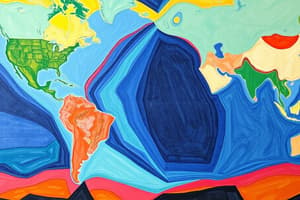Podcast
Questions and Answers
What is the outermost solid layer of the Earth that includes the crust and upper mantle?
What is the outermost solid layer of the Earth that includes the crust and upper mantle?
- Crust
- Asthenosphere
- Mantle
- Lithosphere (correct)
What type of plate boundary is characterized by the movement of two plates sliding past each other horizontally?
What type of plate boundary is characterized by the movement of two plates sliding past each other horizontally?
- Convergent Boundary
- Divergent Boundary
- Continental Drift
- Transform Boundary (correct)
What is the process by which new oceanic crust is created at mid-ocean ridges?
What is the process by which new oceanic crust is created at mid-ocean ridges?
- Magnetic Reversals
- Continental Drift
- Subduction
- Seafloor Spreading (correct)
What is the study of the orientation of magnetic minerals in rocks, providing evidence for continental drift?
What is the study of the orientation of magnetic minerals in rocks, providing evidence for continental drift?
What is the term for the movement of continents relative to each other?
What is the term for the movement of continents relative to each other?
What is the distribution of earthquakes related to?
What is the distribution of earthquakes related to?
What is the observation that the continents fit together like a puzzle?
What is the observation that the continents fit together like a puzzle?
What is the process by which one plate is forced beneath another plate?
What is the process by which one plate is forced beneath another plate?
Flashcards are hidden until you start studying
Study Notes
Plate Tectonics
Definition
- Plate tectonics is the theory that the Earth's lithosphere is broken into large plates that move relative to each other.
Key Components
- Lithosphere: The outermost solid layer of the Earth, including the crust and upper mantle.
- Asthenosphere: The upper mantle beneath the lithosphere, which is capable of flowing over long periods of time.
Types of Plate Boundaries
- Divergent Boundary: Where two plates move apart from each other, resulting in the creation of new crust.
- Examples: Mid-ocean ridges, East African Rift System
- Convergent Boundary: Where two plates move towards each other, resulting in subduction or collision.
- Examples: Andean mountain building, Himalayan orogeny
- Transform Boundary: Where two plates slide past each other horizontally, without creating or destroying crust.
- Examples: San Andreas Fault, North Anatolian Fault
Plate Tectonic Processes
- Seafloor Spreading: The process by which new oceanic crust is created at mid-ocean ridges.
- Subduction: The process by which one plate is forced beneath another plate.
- Continental Drift: The movement of continents relative to each other.
Evidence for Plate Tectonics
- Fit of the Continents: The observation that the continents fit together like a puzzle.
- Mid-Ocean Ridges: The presence of volcanic mountain ranges at the boundaries of tectonic plates.
- Magnetic Reversals: The alternating polarity of magnetic minerals in rocks, indicating changes in the Earth's magnetic field.
- Paleomagnetism: The study of the orientation of magnetic minerals in rocks, providing evidence for continental drift.
- Seismicity: The distribution of earthquakes, which is related to plate boundaries and tectonic activity.
Plate Tectonics
Key Components
- The Earth's outermost solid layer is called the lithosphere, comprising the crust and upper mantle.
- The asthenosphere is the upper mantle beneath the lithosphere, capable of flowing over long periods of time.
Types of Plate Boundaries
- Divergent Boundary: Plates move apart, creating new crust, with examples including Mid-ocean ridges and the East African Rift System.
- Convergent Boundary: Plates move towards each other, resulting in subduction or collision, with examples including Andean mountain building and the Himalayan orogeny.
- Transform Boundary: Plates slide past each other horizontally, without creating or destroying crust, with examples including the San Andreas Fault and the North Anatolian Fault.
Plate Tectonic Processes
- Seafloor Spreading: New oceanic crust is created at mid-ocean ridges.
- Subduction: One plate is forced beneath another plate.
- Continental Drift: Continents move relative to each other.
Evidence for Plate Tectonics
- Fit of the Continents: The continents fit together like a puzzle.
- Mid-Ocean Ridges: Volcanic mountain ranges exist at tectonic plate boundaries.
- Magnetic Reversals: Alternating polarity of magnetic minerals in rocks indicates changes in the Earth's magnetic field.
- Paleomagnetism: The study of magnetic minerals' orientation in rocks provides evidence for continental drift.
- Seismicity: Earthquake distribution is related to plate boundaries and tectonic activity.
Studying That Suits You
Use AI to generate personalized quizzes and flashcards to suit your learning preferences.




